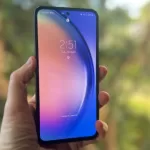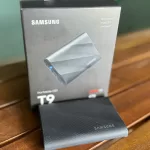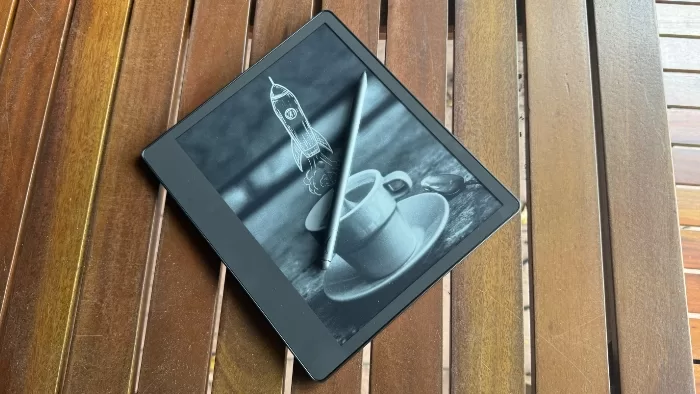
Amazon’s Kindle Scribe redefines its Kindle e-reader model with the option to jot down notes and a massive display, but size isn’t everything in the e-reader space.
| Pros | Cons |
|---|---|
| Large display is great for graphic novels and illustrated books | Large size is less plane-friendly |
| Stylus for easy note-taking | Most Kindle books aren’t note-friendly |
| Can use the scribe to sign PDFs | Expensive by Kindle e-reader standards |
Score: 3/5
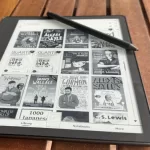 |
Buy The Amazon Kindle Scribe! | Buy On Amazon |
Amazon’s been making e-readers for years now, primarily focusing on providing generally affordable, pocketable devices that appeal to the kinds of readers who want a lot of books at their fingertips in a no-distraction simple device.
The Kindle Scribe is certainly an e-reader with all the classic features you’d expect out of a Kindle, but with a sizeable twist or two. It’s considerably larger than any other Kindle you can buy, it’s considerably more expensive than any other Kindle you can buy, and it’s called the Scribe because it comes with a pen designed to let you write fresh notes and annotate e-books at will.
Not all of this works as smoothly as you might expect, however.
Design
Excluding the classic “Kindle Keyboard” design, Kindles haven’t been particularly complex devices, ever since Amazon switched to a purely touch-based input design. Ostensibly that’s true of the Kindle Scribe too, which features a power button, USB-C input… and that’s it.
But of course I’m underselling the key design difference for the Kindle Scribe, which is that it’s considerably larger than any of its other Kindle siblings.
Its 10.2 inch 300ppi screen dwarfs that of the regular Kindle (6 inch display), Kindle Paperwhite (6.8 inches) or even the Kindle Oasis (7 inches). Keep in mind that screen dimensions are always across the diagonal, so that 3-4 inch difference makes a huge impact on the size of the Kindle Scribe.

How big is the Kindle Scribe? THIS BIG.
It measures in at 196x230x5.8mm, which makes it impossible to fit into just about anything but a side bag or backpack for travel, unless you’re in the habit of wearing clown pants.
Obviously that larger screen does have appeal if you find the smaller screen size of the regular Kindles an issue, and it’s an absolute boon for reading any kind of visual material such as graphic novels or heavily illustrated books or technical documents.

My ten years in the Iso-cubes will pass more swiftly with the Kindle Scribe to keep me company.
The flipside here is that it’s considerably less convenient for one of the key reasons I rather like taking a Kindle with me when I travel. Specifically, it’s not particularly travel-friendly in the way that a regular Kindle is.
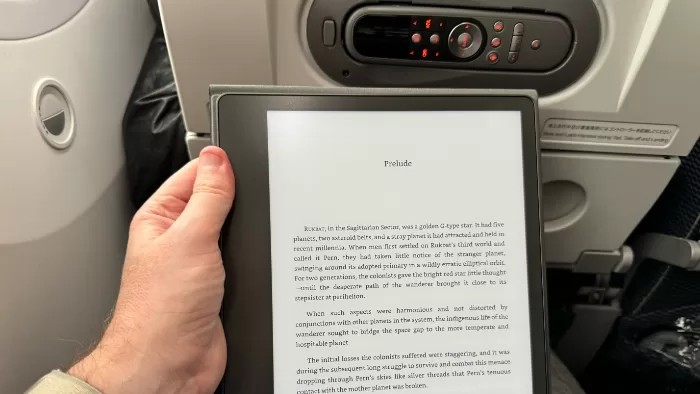
I could read on the Kindle Scribe in-flight — but it was far less comfortable and convenient than on a regular Kindle.
I recently travelled specifically with the Kindle Scribe, and while it was fine if I was reading in bed late one night, it was considerably less convenient when I wanted to read in an economy plane seat.
Performance

The Kindle Scribe interface works just like any other Kindle, with a direct link – once connected to a suitable Wi-Fi source – to Amazon’s Kindle store to buy a wide variety of eBooks across every possible genre. Heck, with naked self-promotion in mind, I’ll take this time to pimp a couple of my own!
 |
Buy Sharksplosion on Kindle! | Buy On Amazon |
 |
Buy Fifty Two on Kindle! | Buy On Amazon |
Ahem. In any case, if the appeal of the Kindle Scribe to you is that it’s a Kindle but bigger, then fill your boots – at least with eBooks, that is, because the Kindle Scribe doesn’t work with Audible titles at all.
The other side of the Kindle Scribe experience comes from the Kindle Pen… or Pens. The lower-cost Kindle Scribe comes with 16GB of onboard storage – which doesn’t sound like a lot, but most eBooks are quite compact in terms of data usage – and the “Basic” Kindle Pen, while the larger tier 32GB or 64GB models ship with the “Premium” Kindle Pen.
So what’s the difference? The premium pen has a configurable shortcut button and an eraser tip at the base, while those features are only available to the basic pen as slower menu-based shortcuts. Amazon sent me the higher capacity model so I’ve only tested with the premium pen, but that’s it. You can buy the Premium pen standalone if you wanted to upgrade or if you lose it, but at $99 a pop it’s not an inexpensive option by itself.
The Premium Pen attaches magnetically to the side of the Kindle Scribe, at least for a while. Standalone, the magnets that attach the Premium Pen to the Kindle Scribe are… not strong.
If Amazon hadn’t sent me the $99 Kindle Scribe Folio Cover, which includes a fabric loop to hold the pen, I’m sure it would have been lost at the bottom of a bag by now.
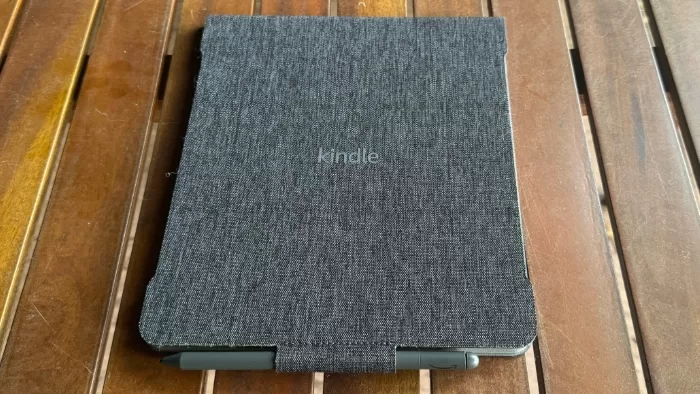
The Folio Cover isn’t a mandatory purchase — but it would be a wise one unless you plan on losing the Premium Pen.
That’s the nature of magnetically attached styluses, as anyone who’s ever used the 2nd Gen Apple Pencil would be able to tell you. They just don’t hold that strongly unless the side of your tablet never gets bumped.
Using the pen on the Kindle Scribe is an interesting affair, depending on your precise needs. The one big interface difference here is the inclusion of a Notebooks tab from the Kindle Scribe home screen, giving you quick access to any personally jotted notes you’ve taken down.
This works quite well with a variety of pen styles on offer and good response from the pen, though it could do little to deal with my admittedly lousy handwriting. The backlit screen on the Kindle Scribe could also be a boon here for you if you’re working in a darkened environment, at the cost of a little battery life, of course.
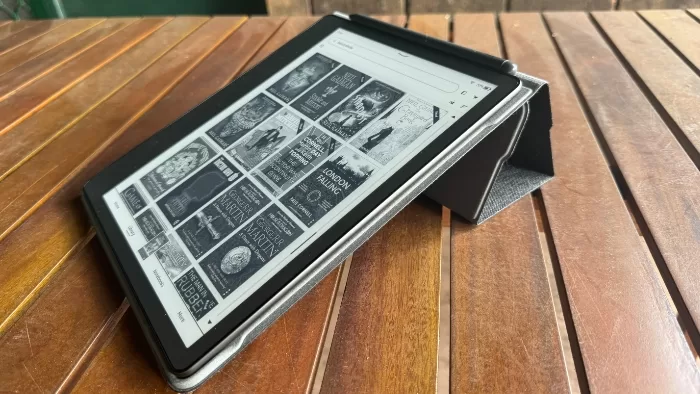
I’m aware that Amazon doesn’t own the scribing tablet market to itself, but I can’t really comment on how the Kindle Scribe compares to devices like the Kobo Elipsa or reMarkable 2 devices, simply because I haven’t tested them as yet. If anyone from Kobo/reMarkable (or other competitors) wants to get in touch, I’m not hard to find.
What I have tested, and what does sit as a more obvious competitor if you just want note jotting would be a device like the entry level iPad, or any number of Android tablet devices.
You’re generally going to have to spend more for a decent stylus (where supported), and naturally battery life won’t be quite as good, but given the base pricing of the Kindle Scribe, those kinds of more fully featured tablets should definitely be in consideration when buying.
Then there’s the tricky issue of annotating other document types. The Kindle Scribe will let you annotate PDFs, but only in one particular way. If you directly load a PDF to the Kindle Scribe (via, say, Calibre), then you can read PDFs all you want, but annotation isn’t possible.
It’s only possible if you use Amazon’s own “Send to Kindle” feature, which means your document has to go through Amazon’s servers for conversion to a scribing-friendly format.
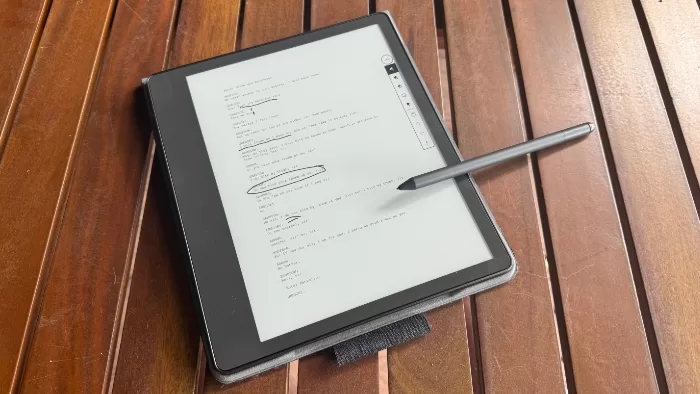
Notes on Romeo & Juliet as a PDF, sent through Amazon’s “Send To Kindle” feature. Though I may have spoiled the ending for some Amazon robot somewhere.
That’s not exactly what I’d call a secure function for any kind of sensitive or personal document, but it’s all you’ve got. You can use Send To Kindle to send other file types such as DOCX, but direct scribing there is not an available feature.
What about more regular book notes? Here I could 100% see the appeal in jotting down notes in the margin or underlining key passages, though I’m 100% in the camp that views that kind of approach as total vandalism when it comes to actual paper books.
However again, you’re largely limited to creating sticky notes in the style of comments that you might get on a Word or Google Docs document, rather than free scribing at will.

There’s a note here. Can you see it?
The notes icons are small and rather easily missed if you do make quite a few of them, too. They’re also not available across all Kindle sold content, with graphic novels (or at least the ones in my library, availability varies) actively blocking the feature.
Amazon does provide a more limited library of “Write On” books to buy through the Kindle store – mostly of the puzzle/sudoku type, which makes a degree of sense – but this can’t help but feel like a limited approach. If I can write, erase and rewrite at will on my Kindle Scribe notebooks, why can’t I do similar to my legitimately purchased Kindle eBooks?
Battery life, as you might expect out of a Kindle, is really very good, and you’d have to be hammering the Kindle Scribe pretty hard to run it flat before you could reach a charger.
Amazon Kindle Scribe: Alex’s Verdict

There’s an obvious appeal with the Kindle Scribe for anyone who wants eBooks but has difficulty with visual acuity on smaller Kindle screens. It would be an absolute boon for anyone who otherwise relies on large print titles for sure.
However, that’s really only looking at half of the equation, because scribing is built into the name of the device. It’s a capable enough jotting device, but I can’t help but feel that you’d be slightly better served with a regular tablet at this price point.
If Amazon could open up its Kindle library to allow a lot more note-taking in a more direct style, though, my opinion there would change. Given the Kindle Scribe has been around for a while, though, I’m not sure that’s going to happen.
Was this review useful to you? Support independent media by dropping a dollar or two in the tip jar below!
Amazon Kindle Scribe: Pricing and availability
The Amazon Kindle Scribe retails in Australia from $599, though like most Kindle devices discounts are remarkably common if you’re purchasing directly through Amazon itself.
 |
Buy The Amazon Kindle Scribe! | Buy On Amazon |


